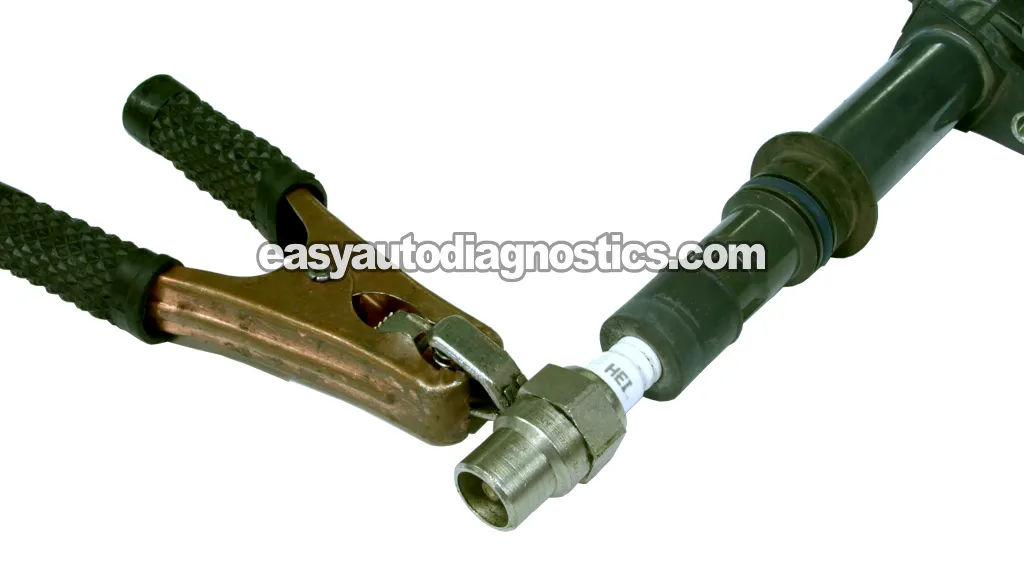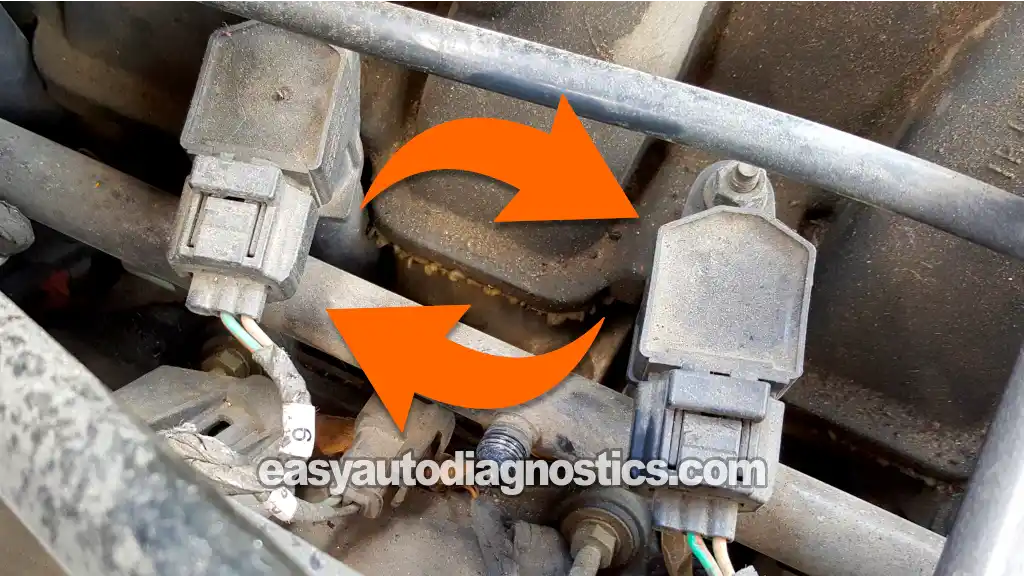
This step-by-step guide shows you exactly how to test each coil using a simple spark tester —no guesswork, no expensive diagnostic tools required.
You'll learn how to spot a dead coil, what to do if there's no spark, and how to confirm the coil is actually bad before replacing it.
So if your 4.7L Dodge Dakota or Durango is misfiring or running rough and you suspect a faulty ignition coil, this guide will help you get to the bottom of it.
Let's get started and find out if one of those ignition coils is the problem.
Contents of this tutorial:
APPLIES TO: This tutorial applies to the following vehicles:
- 4.7L V8 Dodge Dakota: 2000, 2001, 2002, 2003, 2004, 2005, 2006, 2007, 2008, 2009.
- 4.7L V8 Dodge Durango: 2000, 2001, 2002, 2003, 2004, 2005, 2006, 2007, 2008, 2009.
IGNITION SYSTEM TESTS:
- How To Test The CMP Sensor -P0340 (2000-2007 4.7L V8 Dodge Dakota And Durango).
- How To Test The CKP Sensor -P0320, P0335, P0339 (2000-2009 4.7L Dodge Dakota And Durango).
CYLINDER MISFIRE DIAGNOSTICS:
ENGINE NO-START DIAGNOSTICS:
Symptoms Of A Bad COP Ignition Coil
The 4.7L V8 in your Dodge Dakota or Durango uses a Coil-On-Plug (COP) ignition system —one ignition coil per cylinder, mounted right on top of the spark plug.
When one of these COP coils fails, it usually triggers a cylinder misfire. Here are the most common symptoms of a failed ignition coil:
- Rough idle or engine shake —especially noticeable at stoplights or in Park.
- Check Engine Light (CEL) ON —usually with a misfire code like P0301 to P0308 (depending on which cylinder is affected).
- Engine hesitation or stumble when accelerating under load.
- Strong fuel smell from exhaust due to unburned fuel from the dead cylinder.
- Poor MPG —the engine works harder to compensate for the misfire.
Sometimes the misfire is constant. Other times it comes and goes, depending on heat, humidity, or engine load.
Keep in mind, it's extremely rare (well, next to impossible) for all 8 ignition coils to fail at the same time and cause an engine no-start condition. If your 4.7L Dakota or Durango cranks but doesn't start, you're likely dealing with a different issue altogether (like a bad CMP or CKP sensor).
Here's a step-by-step guide that'll help you track it down:
What Tools Do I Need?
You don't need anything fancy to troubleshoot a COP ignition coil on your 4.7L V8 —just a few basic tools and a little patience.
Here's what I recommend having on hand:
- Ratchet and socket set: To remove the ignition coil (and possibly the spark plug too).
- Dedicated spark tester: This is the most reliable way to confirm if an ignition coil is firing —no guessing, no improvised methods.
If you don't already own a spark tester, this is the one I personally use and recommend. It's accurate, affordable, and helps you avoid chasing the wrong problem:
- OTC 6589 Electronic Ignition Spark Tester (Amazon affiliate link).
Using these links helps support the site —and it doesn't cost you anything extra. I really appreciate it.
Should You Just Replace The Ignition Coil?
When your 4.7L Dakota or Durango starts misfiring, it's tempting to skip testing and go straight to replacing the ignition coil —and honestly, that's a valid option.
In fact, many techs and DIYers take that route because it saves time and ignition coils aren't super expensive. But if you do replace it outright, there are a few important things to check first:
- Inspect the coil connector: Make sure the locking tab isn't broken and that the connector fits snugly and clicks into place.
- Check the wiring: Look closely at the wires going into the connector —the insulation often cracks and dry-rots, exposing bare copper near the base.
- Remove the ignition coil: If it's soaked in oil, you're probably dealing with a leaking valve cover gasket that needs fixing.
These issues can affect coil performance or come back to haunt you if left unaddressed —so it's worth taking a minute to look them over.
If you're leaning toward replacing the coil, here are two I recommend —they're reliable, well-made, and from trusted brands:
- Standard Motor Products UF270T Ignition Coil (Amazon affiliate link)
- Delphi GN10456 Pencil Ignition Coil (Amazon affiliate link)
Buying through these links helps support the site and keeps tutorials like this free —at no extra cost to you. I really appreciate it!
But if you'd rather test the coil first (which is what I personally recommend), the process is quick and easy —and I'll walk you through every step in this tutorial.
Where To Buy The Ignition Coil And Save
If you're ready to replace the coil, here are two options from trusted brands I've used throughout my career —they're reliable, well-priced, and ship fast from Amazon.
Disclosure: As an Amazon Associate, I earn from qualifying purchases. Buying through these links helps support this site at no extra cost to you. Thanks for your support —it really means a lot!
TEST 1: Checking The Ignition Coil For Spark

I'm gonna assume you've already got a misfire trouble code and have pinpointed the misfiring cylinder —so you're just testing that one ignition coil.
But if you haven't found the misfiring cylinder yet, you'll need to scan for trouble codes or run a manual cylinder balance test. Here's a guide that shows you how:
If you'd rather test all eight coils, that's totally fine too —the steps I'm about to show you'll work either way.
Step one in tracking down an ignition-related misfire is to check whether the coil is actually producing spark.
For that, I recommend using an HEI spark tester. But if you've got a different type, use what you've got —I prefer the HEI because it gives a clear result and saves you from guessing about spark color or strength.
Once you've got your tester ready, here's how to set up and run the test:
- 1
Take the ignition coil off its mounting point.
- 2
Connect your HEI spark tester to the coil's output —right where the spark plug normally goes.
- 3
Secure the spark tester to a solid Ground.
The best spot? Clip it to the negative (-) terminal on the battery using a battery jump start cable (my preferred method). - 4
Have a helper crank the engine while you keep an eye on the tester for spark.
- 5
You're looking for one of two results: Spark or no spark. Simple as that.
Let's break down what your results mean:
CASE 1: You saw spark. That's a good sign —this coil is doing its job.
But if you've got a misfire code for this cylinder, don't stop here. A few common problems that could still be causing the misfire:
- Oil leaking into the spark plug well from a worn valve cover gasket.
- Spark plug with carbon tracking (tiny lightning bolt lines).
- Low compression in the cylinder itself.
If you haven't already, be sure to check out the full misfire diagnostic guide for the 4.7L V8:
CASE 2: No spark at all. In most cases, this means the ignition coil has failed —but let's double-check to be sure.
Before replacing anything, swap this coil with a known good one from another cylinder and re-run the spark test.
If the new coil sparks and this one still doesn't, you've confirmed it —the original coil is toast. For the swap test, head to: TEST 2: Swap The 'No Spark' Ignition Coil.
TEST 2: Swap The 'No Spark' Ignition Coil

If one of your ignition coils didn't produce spark back in TEST 1, there's a good chance it's faulty —but before replacing it, this quick coil swap test can confirm it for sure.
Here's how it works: take a known-good ignition coil from another cylinder and plug it into the connector of the suspect coil —the one that didn't spark.
If the good coil fires in that spot, then you've just confirmed that the original connector is supplying both power and the PCM's activation signal. That means the coil you pulled out is bad.
And to close the loop, you can take that suspect coil and plug it into the location of the known-good one. If it still doesn't spark there, that seals it —the coil is toast.
This swap test is one of the quickest and easiest ways to rule out wiring or signal issues and know for sure whether it's the coil or something else causing the problem.
Here's how to do it step-by-step:
- 1
Remove the ignition coil that didn't produce spark during your last test.
- 2
Pick another coil that you know is working, unplug it, and take it out of its cylinder.
If you're not sure it sparks, you can double-check with your HEI spark tester first. - 3
Connect the good coil to the connector from the suspect cylinder.
Then attach your spark tester to the good coil and Ground it to the negative battery terminal using a jumper cable. - 4
Mount the original no-spark coil into the good coil's old position and bolt it down —just to keep it out of the way for now.
- 5
With everything in place, have a helper crank the engine while you observe the spark tester.
- 6
The ignition coil should spark.
Now let's break down what your results mean:
CASE 1: The good coil sparked in the suspect location. That confirms the ignition coil you removed earlier is bad and should be replaced.
Why? Because the good coil just confirmed that the connector (of the suspect location) is delivering 12 Volts and an ignition coil activation signal.
If you're ready to replace the coil, here are two quality options I personally recommend —reliable, properly fitting, and from brands I've trusted for years:
- Standard Motor Products UF270T Ignition Coil (Amazon affiliate link)
- Delphi GN10456 Pencil Ignition Coil (Amazon affiliate link)
CASE 2: The good coil didn't spark either. That tells us the coil is fine —so the issue lies in the wiring or signal side of the circuit.
Here's what to check next:
- One wire should supply 10–12 Volts —usually the:
- 2000-2004: Dark green with orange stripe (DK GRN/ORG) wire.
- 2005-2009: Red (RED) wire.
- The other wire should carry the switching signal from the PCM.
If the power wire checks out but you're missing the switching signal, there could be an open-circuit between the PCM and the coil connector —or a problem with the PCM itself.
PCM failures are rare, but they do happen. Diagnosing that is beyond the scope of this guide, but now you've got a clear path to follow.
More 4.7L V8 Dodge Dakota And Durango Tutorials
If you're wrenching on your Dodge Dakota or Durango, the guide you just finished is just the tip of the iceberg.
Over the years, I've put together a growing library of step-by-step diagnostic tutorials, wiring diagrams, and real-world how-to's for the 4.7L V8 —the kind of stuff you won't find in a generic repair manual.
Whether you're chasing down a no-start, misfire, sensor issue, or just want to understand your truck better, the index is your go-to starting point:
Here's a small sample of what's waiting for you there:
- How To Test The Throttle Position Sensor (2000-2007 4.7L V8 Dodge Dakota And Durango).
- How Often Should I Replace The Spark Plugs? (2000-2009 4.7L V8 Dodge Dakota And Durango).
- How To Test The Alternator (2001-2002 4.7L V8 Dodge Dakota And Durango).
- How To Test The Fuel Pump (2000-2007 4.7L V8 Dodge Dakota And Durango).

If this info saved the day, buy me a beer!



